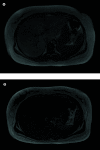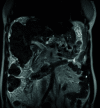Imaging of chemotherapy-induced liver toxicity: an illustrated overview
- PMID: 34765105
- PMCID: PMC8577512
- DOI: 10.2217/hep-2020-0026
Imaging of chemotherapy-induced liver toxicity: an illustrated overview
Abstract
Chemotherapy is a potential cause of focal and diffuse hepatobiliary lesions. Many of these lesions may be demonstrated on imaging, especially computed tomography and MRI. Some of these lesions, especially those of steatosis and sinusoidal obstruction syndrome, are associated with a worse prognosis and risk of hepatic failure in the context of surgical management. Notably, some chemotherapy-induced hepatic alterations, such as sinusoidal obstruction syndrome, pseudocirrhosis and focal hepatopathies, may be mistakenly interpreted as signs of cancer progression, misguiding the therapeutic planning for patients receiving chemotherapy.
Keywords: adverse effects; chemotherapy; hepatology; imaging; liver; magnetic resonance; oncology.
© 2021 Giovanni Brondani Torri and authors.
Conflict of interest statement
Financial & competing interests disclosure The authors have no relevant affiliations or financial involvement with any organization or entity with a financial interest in or financial conflict with the subject matter or materials discussed in the manuscript. This includes employment, consultancies, honoraria, stock ownership or options, expert testimony, grants or patents received or pending, or royalties. No writing assistance was utilized in the production of this manuscript.
Figures








Similar articles
-
CT and MR imaging of chemotherapy-induced hepatopathy.Abdom Radiol (NY). 2019 Oct;44(10):3312-3324. doi: 10.1007/s00261-019-02193-y. Abdom Radiol (NY). 2019. PMID: 31435760 Review.
-
Hepatic Lesions that Mimic Metastasis on Radiological Imaging during Chemotherapy for Gastrointestinal Malignancy: Recent Updates.Korean J Radiol. 2017 May-Jun;18(3):413-426. doi: 10.3348/kjr.2017.18.3.413. Epub 2017 Apr 3. Korean J Radiol. 2017. PMID: 28458594 Free PMC article. Review.
-
Accuracy of gadoxetic acid-enhanced magnetic resonance imaging for the diagnosis of sinusoidal obstruction syndrome in patients with chemotherapy-treated colorectal liver metastases.Eur Radiol. 2012 Apr;22(4):864-71. doi: 10.1007/s00330-011-2333-x. Epub 2011 Nov 23. Eur Radiol. 2012. PMID: 22108766
-
Oxaliplatin-induced sinusoidal obstruction syndrome mimicking metastatic colon cancer in the liver.Oncol Lett. 2016 Apr;11(4):2861-2864. doi: 10.3892/ol.2016.4286. Epub 2016 Feb 29. Oncol Lett. 2016. PMID: 27073565 Free PMC article.
-
Chemotherapy induced liver abnormalities: an imaging perspective.Clin Mol Hepatol. 2014 Sep;20(3):317-26. doi: 10.3350/cmh.2014.20.3.317. Clin Mol Hepatol. 2014. PMID: 25320738 Free PMC article.
Cited by
-
Multi-omics characterization reveals the pathogenesis of liver focal nodular hyperplasia.iScience. 2022 Aug 11;25(9):104921. doi: 10.1016/j.isci.2022.104921. eCollection 2022 Sep 16. iScience. 2022. PMID: 36060063 Free PMC article.
-
The role of MRI in modifying surgical management of colorectal liver metastases: a lesson from the CAMINO trial.Hepatobiliary Surg Nutr. 2024 Oct 1;13(5):837-840. doi: 10.21037/hbsn-24-340. Epub 2024 Sep 4. Hepatobiliary Surg Nutr. 2024. PMID: 39507725 Free PMC article. No abstract available.
References
-
- Liu YI, Jha P, Wang ZJ et al. Abdominal complications of chemotherapy: findings at computed tomography. Clin. Imaging 36(1), 54–60 (2012). - PubMed
-
- Miyake K, Hayakawa K, Nishino M, Morimoto T, Mukaihara S. Effects of oral 5-fluorouracil drugs on hepatic fat content in patients with colon cancer. Acad. Radiol. 12(6), 722–727 (2005). - PubMed
-
- McGettigan MJ, Menias CO, Gao ZJ, Mellnick VM, Hara AK. Imaging of drug-induced complications in the gastrointestinal system. Radiographics 36(1), 71–87 (2016). - PubMed
-
- Sharma A, Houshyar R, Bhosale P, Choi J-I, Gulati R, Lall C. Chemotherapy induced liver abnormalities: an imaging perspective. Clin. Mol. Hepatol. 20(3), 317–326 (2014). - PMC - PubMed
-
• This report presents a comprehensive review of chemotherapy-related complications, including vascular complications such as portal vein thrombosis.
-
- Guglielmo FF, Venkatesh SK, Mitchell DG. Liver MR elastography technique and image interpretation: pearls and pitfalls. Radiographics 39(7), 1983–2002 (2019). - PubMed
-
• Describes the peculiarities involving magnetic resonance elastography, which might help to differentiate steatosis from steatohepatitis.
Publication types
LinkOut - more resources
Full Text Sources
